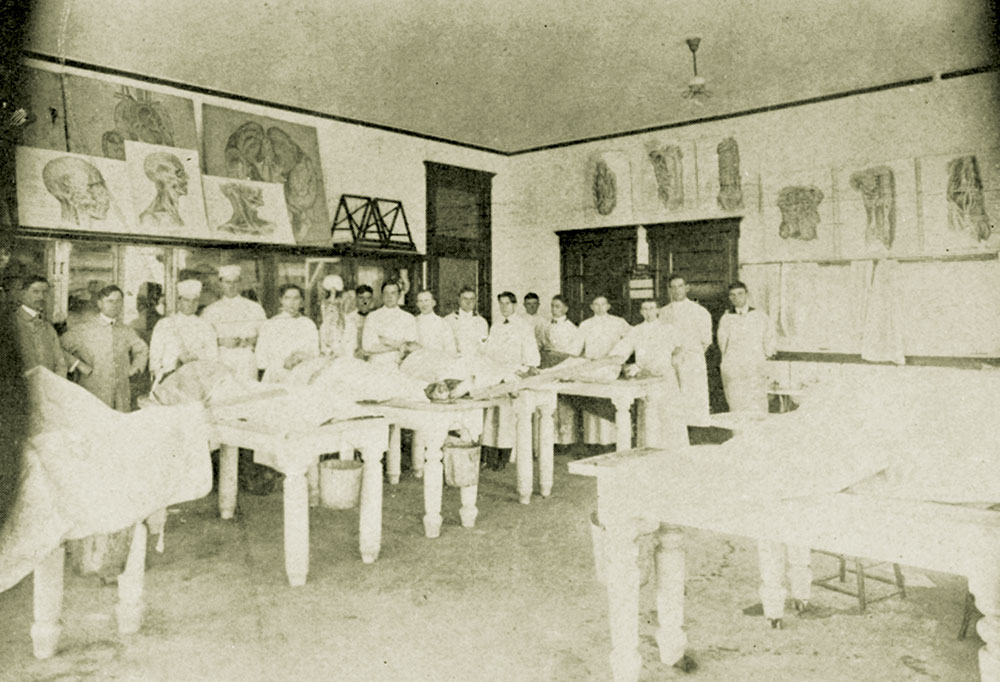History of TCU Pre-Health Professions

A 1914 class in the TCU Medical College (Photo courtesy 1914 Horned Frog)
History of TCU Pre-Health Professions
1911: TCU takes over operations of the Fort Worth School of Medicine in downtown.
1912: The American Medical Association issues new requirements forcing medical schools to have hefty endowments. By 1917, the university is warned it is not in compliance and the board of trustees closes TCU’s medical school.
1913: Story in the Horned Frog notes the beginning of a new program for pre-health majors. Biology Professor Will Winton serves as chair.
1918: Pre-health courses mentioned in the TCU course catalog. Students had two options: 1) the AMA-recommended curriculum of two years of study that included math, biology, English, modern language, physics, chemistry and an elective. Students who completed the minimum two years of coursework could be admitted to medical school. 2) Students who took course work in addition to that recommended by the AMA that included classes in Bible, history and philosophy would simultaneously be granted their undergraduate degree by TCU when they earned their medical degree (provided the dean of the College of Arts and Sciences approved of the medical school).

1923-1924: The course catalog states: “There is an esprit de corps in the Science Departments under the general Chairmanship of Prof. Winton that brings out the best of every student. To guide the career of a worthwhile student and secure opportunities for advanced study is one of the joys of this Department.”
The catalog also mentions the Pre-Medic club, indicating that this group “gives the students the opportunity for mutual helpfulness, and brings them many extra features as well as fellowship.”
1943: Winton leads TCU’s Navy V-12 training program and Professor Willis G. Hewatt is asked by President Sadler to advise the pre-med/pre-dent trainees.
During the World War II years, 37 of the program’s Naval officers are admitted to medical school and five are admitted to dental colleges.
 1950: Winton steps down as chair of the pre-health program and Hewatt takes over.
1950: Winton steps down as chair of the pre-health program and Hewatt takes over.
1964: Hewatt reports that 361 of the program’s graduates had gone on to medical school and that 97 members of the Tarrant County Medical Society — 21 percent — are TCU grads.
1972: Chemistry Professor Manfred Reinecke takes over as chair of the pre-health program as Hewatt steps down.
1975: The TCU Pre-Med/Pre-Dent Honor Society is formed with Reinecke as its faculty advisor.
1978: TCU’s Pre-Med/Pre-Dent Honor Society petitions to affiliate with Alpha Epsilon Delta, the world’s largest group devoted to pre-medical education. A year later, the Texas Zeta Chapter of AED is established at TCU with the initiation of 31 active members, three active alumni and five honorary members.

1991: Reinecke steps down as pre-health chair. The following year, biology Professor Phil Hartman takes over running the program.
1995: Dr. Elliot Trotter, an emergency department physician at Harris Methodist Hospital in downtown Fort Worth, contacts Pre-Health Chair Phil Hartman to inquire about employing a few TCU students to work in the emergency department. It becomes the beginning of the Scribe program, which pairs students with physicians to assist with medical records, ordering of lab results and related needs.
1998: TCU’s AED chapter helps organize the group’s national convention in Fort Worth.
1999: The program initiates a “mock” interview process, giving students three practice interviews before they meet with admission officials from professional programs.

2003: A chemistry tutorial program begins. Funded by the College of Science and Engineering Dean’s Office, four to six undergraduates are employed to assist students needing help with general chemistry and organic chemistry.
2003: The program’s office moves to the ground floor of the Sid W. Richardson Building to boost student traffic. In 2010, the offices get upgrades including a flat-screen TV, contributed by Chancellor Victor J. Boschini Jr. for “study purposes.”
2003: Denise Bennett joins the program as an administrative assistant and serves as a surrogate mother figure to many students. In 2008, she’s awarded the Wassenich Award for mentoring to the TCU community. In 2012, she loses her battle with cancer.
2010: The national AED office moves to TCU and TCU’s chapter is featured on the cover of the society’s national magazine The Scalpel.

2012: Jill Fritchen joins the staff as administrative program specialist.
2013: Hartman is named Dean of the College of Science and Engineering. Matt Chumchal ’03 MS, associate professor of biology, takes over as director of the Pre-Health Professions Program and Shauna McGillivray, assistant professor of biology, is named associate director.
2013: The program becomes the TCU Pre-Health Professions Institute.
Related stories:
The Doctors Are In: 100 years of Pre-Health Professions at TCU
History of TCU Pre-Health Professions
Work Hard, Play Hard
TCU’s original medical college

Your comments are welcome
Comments
Related Reading:
Features
A Prescription for Success
TCU’s health policy program from the Neeley School of Business trains medical industry professionals in the business of health care.
Features
Campus of the Future
TCU’s Campus Master Plan builds on the university’s vision and values.